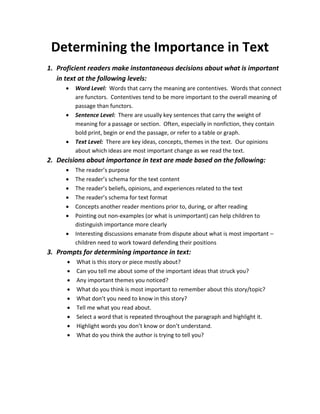
Determining the importance in text
- 1. Determining the Importance in Text 1. Proficient readers make instantaneous decisions about what is important in text at the following levels: Word Level: Words that carry the meaning are contentives. Words that connect are functors. Contentives tend to be more important to the overall meaning of passage than functors. Sentence Level: There are usually key sentences that carry the weight of meaning for a passage or section. Often, especially in nonfiction, they contain bold print, begin or end the passage, or refer to a table or graph. Text Level: There are key ideas, concepts, themes in the text. Our opinions about which ideas are most important change as we read the text. 2. Decisions about importance in text are made based on the following: The reader’s purpose The reader’s schema for the text content The reader’s beliefs, opinions, and experiences related to the text The reader’s schema for text format Concepts another reader mentions prior to, during, or after reading Pointing out non-examples (or what is unimportant) can help children to distinguish importance more clearly Interesting discussions emanate from dispute about what is most important – children need to work toward defending their positions 3. Prompts for determining importance in text: What is this story or piece mostly about? Can you tell me about some of the important ideas that struck you? Any important themes you noticed? What do you think is most important to remember about this story/topic? What don’t you need to know in this story? Tell me what you read about. Select a word that is repeated throughout the paragraph and highlight it. Highlight words you don’t know or don’t understand. What do you think the author is trying to tell you?
- 2. Sample Strategy Study: The teacher begins by modeling: thinking aloud about his/her own process of determining importance during reading. Modeling should occur frequently using short selections. The teacher should focus not only on conclusions about importance, but on how and why he or she arrived at those conclusions. It is important to think aloud about how the focus on what he or she believes to be important enhances comprehension. In small and large group mini-lessons, students are gradually invited to share their thoughts about what is important at the whole-text level, and later at the word and sentence level. Students should provide some evidence or reasoning to support their judgments. Students may meet in small groups or pairs to compare ideas about what is most important in text and how they came to that conclusion. They should be asked to discuss how their comprehension is enhanced by focusing on themes they believe to be important. Book clubs focus on determining importance during strategy study. They discuss different conclusions about important ideas if all are reading the same text, or ways in which the members of the book club drew conclusions about importance if each is reading a different book. In reading conferences with students, conversation can focus on what decisions the child is making about important ideas in a variety of texts. Think-alouds are an effective way to assess the student’s use of the strategy. Invitational (needs-based) groups are created for children who need more modeling and explicit instruction. Text sets can be used to invite children to draw conclusions about important themes found in all (or most) books with a common characteristic, i.e., books by the same author, or books about the same topic, books with poetic language, books with strong lead sentences or passages, books written in a particular style or format, etc. Sharing time at the conclusion of the reader’s workshop should focus on ideas individual children found important in their independent reading for the day, how they arrived at their conclusions, and how thinking about important ideas enhanced their comprehension. Connections between this strategy and other strategies the children have learned should be made throughout the study. Modeling in a variety of texts – genre and difficulty – is critical. Modeling is most concentrated at the beginning of a strategy study, but does continue throughout. Students may gradually assume responsibility for modeling their own conclusions about importance in texts they are reading. Mosaic of Thought p. 95-96